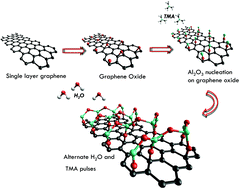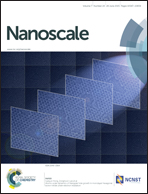Graphene oxide monolayers as atomically thin seeding layers for atomic layer deposition of metal oxides†
Abstract
Graphene oxide (GO) was explored as an atomically-thin transferable seed layer for the atomic layer deposition (ALD) of dielectric materials on any substrate of choice. This approach does not require specific chemical groups on the target surface to initiate ALD. This establishes GO as a unique interface which enables the growth of dielectric materials on a wide range of substrate materials and opens up numerous prospects for applications. In this work, a mild oxygen plasma treatment was used to oxidize graphene monolayers with well-controlled and tunable density of epoxide functional groups. This was confirmed by synchrotron-radiation photoelectron spectroscopy. In addition, density functional theory calculations were carried out on representative epoxidized graphene monolayer models to correlate the capacitive properties of GO with its electronic structure. Capacitance–voltage measurements showed that the capacitive behavior of Al2O3/GO depends on the oxidation level of GO. Finally, GO was successfully used as an ALD seed layer for the deposition of Al2O3 on chemically inert single layer graphene, resulting in high performance top-gated field-effect transistors.



 Please wait while we load your content...
Please wait while we load your content...